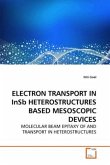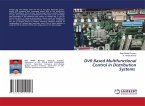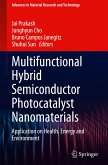Multifunctional Oxide Heterostructures
Herausgeber: Tsymbal, Evgeny Y; Ramesh, Ramamoorthy; Eom, Chang-Beom; Dagotto, Elbio R a
Multifunctional Oxide Heterostructures
Herausgeber: Tsymbal, Evgeny Y; Ramesh, Ramamoorthy; Eom, Chang-Beom; Dagotto, Elbio R a
- Gebundenes Buch
- Merkliste
- Auf die Merkliste
- Bewerten Bewerten
- Teilen
- Produkt teilen
- Produkterinnerung
- Produkterinnerung
This book explores the rapidly developing field of oxide thin-films and heterostructures, which exhibit unusual physical properties interesting from the fundamental point of view and for device application. The chapters, written by world-recognized scientists, discuss topics that represent some of the key innovations in the field over recent years.
Andere Kunden interessierten sich auch für
![ELECTRON TRANSPORT IN InSb HETEROSTRUCTURES BASED MESOSCOPIC DEVICES ELECTRON TRANSPORT IN InSb HETEROSTRUCTURES BASED MESOSCOPIC DEVICES]() Niti GoelELECTRON TRANSPORT IN InSb HETEROSTRUCTURES BASED MESOSCOPIC DEVICES44,99 €
Niti GoelELECTRON TRANSPORT IN InSb HETEROSTRUCTURES BASED MESOSCOPIC DEVICES44,99 €![Strained Silicon Heterostructures Strained Silicon Heterostructures]() Strained Silicon Heterostructures160,99 €
Strained Silicon Heterostructures160,99 €![Defects in Self-Catalysed III-V Nanowires Defects in Self-Catalysed III-V Nanowires]() James A. GottDefects in Self-Catalysed III-V Nanowires117,99 €
James A. GottDefects in Self-Catalysed III-V Nanowires117,99 €![Defects in Self-Catalysed III-V Nanowires Defects in Self-Catalysed III-V Nanowires]() James A. GottDefects in Self-Catalysed III-V Nanowires171,19 €
James A. GottDefects in Self-Catalysed III-V Nanowires171,19 €![DVR Based Multifunctional Control in Distribution Systems DVR Based Multifunctional Control in Distribution Systems]() Raja Reddy DuvvuruDVR Based Multifunctional Control in Distribution Systems26,99 €
Raja Reddy DuvvuruDVR Based Multifunctional Control in Distribution Systems26,99 €![Multifunctional Adaptive Microwave Circuits and Systems Multifunctional Adaptive Microwave Circuits and Systems]() Michael SteerMultifunctional Adaptive Microwave Circuits and Systems142,99 €
Michael SteerMultifunctional Adaptive Microwave Circuits and Systems142,99 €![Multifunctional Hybrid Semiconductor Photocatalyst Nanomaterials Multifunctional Hybrid Semiconductor Photocatalyst Nanomaterials]() Multifunctional Hybrid Semiconductor Photocatalyst Nanomaterials95,99 €
Multifunctional Hybrid Semiconductor Photocatalyst Nanomaterials95,99 €-
-
-
This book explores the rapidly developing field of oxide thin-films and heterostructures, which exhibit unusual physical properties interesting from the fundamental point of view and for device application. The chapters, written by world-recognized scientists, discuss topics that represent some of the key innovations in the field over recent years.
Produktdetails
- Produktdetails
- Verlag: Oxford University Press, USA
- Seitenzahl: 416
- Erscheinungstermin: 25. Oktober 2012
- Englisch
- Abmessung: 254mm x 176mm x 27mm
- Gewicht: 1018g
- ISBN-13: 9780199584123
- ISBN-10: 0199584125
- Artikelnr.: 36052992
- Verlag: Oxford University Press, USA
- Seitenzahl: 416
- Erscheinungstermin: 25. Oktober 2012
- Englisch
- Abmessung: 254mm x 176mm x 27mm
- Gewicht: 1018g
- ISBN-13: 9780199584123
- ISBN-10: 0199584125
- Artikelnr.: 36052992
Evgeny Tsymbal is a Charles Bessey Professor at the Department of Physics and Astronomy of the University of Nebraska-Lincoln (UNL) and the Director of the UNL's Materials Research Science and Engineering Center (MRSEC). Evgeny Tsymbal's research is focused on computational materials science aiming at the understanding of fundamental properties of advanced ferromagnetic and ferroelectric nanostructures and materials relevant to nanoelectronics and spintronics. His research has been supported by the National Science Foundation, Semiconductor Research Corporation, the Office of Naval Research, the Department of Energy, Seagate Technology, and the W. M. Keck Foundation. Evgeny Tsymbal is a fellow of the American Physical Society, a fellow of the Institute of Physics, UK, and a recipient of the UNL's College of Arts & Sciences Outstanding Research and Creativity Award (ORCA). Elbio Dagotto is a Distinguished Professor of Physics at the University of Tennessee, and Distinguished Scientist at the Materials Science and Technology Division of Oak Ridge National Laboratory. He specializes in the study of model Hamiltonians for systems where strong correlations among the electrons play a fundamental role, using a variety of many-body approximations particularly computational techniques. Dagotto's research has been mainly supported by the National Science Foundation and by the Department of Energy. Dagotto is Fellow of the American Association for the Advancement of Science and of the American Physical Society. He was member of the Solid State Sciences Committee of the National Academy of Sciences and divisional editor of the Physical Review Letters. As of September 2011, Dagotto has over 300 publications (h=62), and has directed the work of 13 graduate students and 24 postdoctoral assistants. Chang-Beom Eom is currently a Harvey D. Spangler Distinguished Professor of Materials Science and Engineering and Physics at the University of Wisconsin-Madison. His research focuses on epitaxial thin film heterostructures of complex oxides, including ferroelectrics, piezoelectrics, multiferroics, superconductors, and novel two-dimensional electron gases at oxide interfaces, with an emphasis on understanding fundamental solid state phenomena and developing novel device applications. Ramamoorthy Ramesh is currently the Plato Malozemoff Chair Professor in Materials Science and Physics at University of California, Berkeley. His current research interests include thermoelectric and photovoltaic energy conversion in complex oxide heterostructures. He has published extensively on the synthesis and materials physics of complex oxide materials. He received the Humboldt Senior Scientist Prize and Fellowship to the American Physical Society (2001). In 2005, he was elected a Fellow of American Association for the Advancement of Science as well as the David Adler Lectureship of the American Physical Society. In 2007, he was awarded the Materials Research Society David Turnbull Lectureship Award and in 2009, he was elected Fellow of MRS and is the recipient of the 2010 APS McGroddy New Materials Prize. He is currently serving as the Director of the Dollar a Watt, SunShot program at the U.S. Department of Energy, overseeing the R&D activities of the Solar Program.
* Preface
* Part I. Fundamentals
* 1: E. Dagotto and Y. Tokura: A Brief Introduction to Strongly
Correlated Electronic Materials
* 2: Gustau Catalan and James F. Scott: Magnetoelectric Coupling and
Multiferroic Materials
* Part II. Oxide Films and Interfaces: Growth and Characterization
* 3: Thomas Tybell and Chang-Beom Eom: Synthesis of Epitaxial
Multiferroic Oxide Thin Films
* 4: Dillon D. Fong: Synchrotron X-Ray Scattering Studies of Oxide
Heterostructures
* 5: M. Varela, C. Leon, J. Santamaria, and S. J. Pennycook: Scanning
Transmission Electron Microscopy of Oxides
* 6: A. Gruverman: Advanced Modes of Piezoresponse Force Microscopy for
Ferroelectric Nanostructures
* Part III. Oxide Films and Interfaces: Functional Properties
* 7: Takuya Higuchi and Harold Y. Hwang: General Considerations of the
Electrostatic Boundary Conditions in Oxide Heterostructures
* 8: Satoshi Okamoto: Strongly-Correlated Heterostructures
* 9: Anand Bhattacharya, Shuai Dong, and Rong Yu: Manganites
Multilayers
* 10: Hiromichi Ohta and Kunihito Koumoto: Thermoelectric Oxides: Films
and Heterostructures
* Part IV. Applications
* 11: Suman Datta and Darrell G. Schlom: High-K Gate Dielectrics for
Advanced CMOS
* 12: Hiroshi Ishiwara: FeFET and Ferroelectric Random Access Memories
* 13: Daniela F. Bogorin, Patrick Irvin, Cheng Cen, and Jeremy Levy:
LaAlO3/SrTiO3-Based Device Concepts
* Part I. Fundamentals
* 1: E. Dagotto and Y. Tokura: A Brief Introduction to Strongly
Correlated Electronic Materials
* 2: Gustau Catalan and James F. Scott: Magnetoelectric Coupling and
Multiferroic Materials
* Part II. Oxide Films and Interfaces: Growth and Characterization
* 3: Thomas Tybell and Chang-Beom Eom: Synthesis of Epitaxial
Multiferroic Oxide Thin Films
* 4: Dillon D. Fong: Synchrotron X-Ray Scattering Studies of Oxide
Heterostructures
* 5: M. Varela, C. Leon, J. Santamaria, and S. J. Pennycook: Scanning
Transmission Electron Microscopy of Oxides
* 6: A. Gruverman: Advanced Modes of Piezoresponse Force Microscopy for
Ferroelectric Nanostructures
* Part III. Oxide Films and Interfaces: Functional Properties
* 7: Takuya Higuchi and Harold Y. Hwang: General Considerations of the
Electrostatic Boundary Conditions in Oxide Heterostructures
* 8: Satoshi Okamoto: Strongly-Correlated Heterostructures
* 9: Anand Bhattacharya, Shuai Dong, and Rong Yu: Manganites
Multilayers
* 10: Hiromichi Ohta and Kunihito Koumoto: Thermoelectric Oxides: Films
and Heterostructures
* Part IV. Applications
* 11: Suman Datta and Darrell G. Schlom: High-K Gate Dielectrics for
Advanced CMOS
* 12: Hiroshi Ishiwara: FeFET and Ferroelectric Random Access Memories
* 13: Daniela F. Bogorin, Patrick Irvin, Cheng Cen, and Jeremy Levy:
LaAlO3/SrTiO3-Based Device Concepts
* Preface
* Part I. Fundamentals
* 1: E. Dagotto and Y. Tokura: A Brief Introduction to Strongly
Correlated Electronic Materials
* 2: Gustau Catalan and James F. Scott: Magnetoelectric Coupling and
Multiferroic Materials
* Part II. Oxide Films and Interfaces: Growth and Characterization
* 3: Thomas Tybell and Chang-Beom Eom: Synthesis of Epitaxial
Multiferroic Oxide Thin Films
* 4: Dillon D. Fong: Synchrotron X-Ray Scattering Studies of Oxide
Heterostructures
* 5: M. Varela, C. Leon, J. Santamaria, and S. J. Pennycook: Scanning
Transmission Electron Microscopy of Oxides
* 6: A. Gruverman: Advanced Modes of Piezoresponse Force Microscopy for
Ferroelectric Nanostructures
* Part III. Oxide Films and Interfaces: Functional Properties
* 7: Takuya Higuchi and Harold Y. Hwang: General Considerations of the
Electrostatic Boundary Conditions in Oxide Heterostructures
* 8: Satoshi Okamoto: Strongly-Correlated Heterostructures
* 9: Anand Bhattacharya, Shuai Dong, and Rong Yu: Manganites
Multilayers
* 10: Hiromichi Ohta and Kunihito Koumoto: Thermoelectric Oxides: Films
and Heterostructures
* Part IV. Applications
* 11: Suman Datta and Darrell G. Schlom: High-K Gate Dielectrics for
Advanced CMOS
* 12: Hiroshi Ishiwara: FeFET and Ferroelectric Random Access Memories
* 13: Daniela F. Bogorin, Patrick Irvin, Cheng Cen, and Jeremy Levy:
LaAlO3/SrTiO3-Based Device Concepts
* Part I. Fundamentals
* 1: E. Dagotto and Y. Tokura: A Brief Introduction to Strongly
Correlated Electronic Materials
* 2: Gustau Catalan and James F. Scott: Magnetoelectric Coupling and
Multiferroic Materials
* Part II. Oxide Films and Interfaces: Growth and Characterization
* 3: Thomas Tybell and Chang-Beom Eom: Synthesis of Epitaxial
Multiferroic Oxide Thin Films
* 4: Dillon D. Fong: Synchrotron X-Ray Scattering Studies of Oxide
Heterostructures
* 5: M. Varela, C. Leon, J. Santamaria, and S. J. Pennycook: Scanning
Transmission Electron Microscopy of Oxides
* 6: A. Gruverman: Advanced Modes of Piezoresponse Force Microscopy for
Ferroelectric Nanostructures
* Part III. Oxide Films and Interfaces: Functional Properties
* 7: Takuya Higuchi and Harold Y. Hwang: General Considerations of the
Electrostatic Boundary Conditions in Oxide Heterostructures
* 8: Satoshi Okamoto: Strongly-Correlated Heterostructures
* 9: Anand Bhattacharya, Shuai Dong, and Rong Yu: Manganites
Multilayers
* 10: Hiromichi Ohta and Kunihito Koumoto: Thermoelectric Oxides: Films
and Heterostructures
* Part IV. Applications
* 11: Suman Datta and Darrell G. Schlom: High-K Gate Dielectrics for
Advanced CMOS
* 12: Hiroshi Ishiwara: FeFET and Ferroelectric Random Access Memories
* 13: Daniela F. Bogorin, Patrick Irvin, Cheng Cen, and Jeremy Levy:
LaAlO3/SrTiO3-Based Device Concepts








